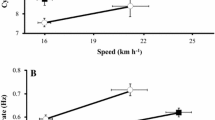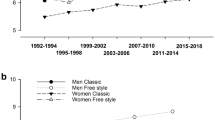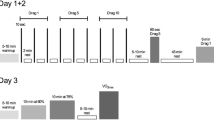Abstract
The present study investigated metabolic rate (MR) and gross efficiency (GE) at moderate and high work rates, and the relationships to gross kinematics and physical characteristics in elite cross-country skiers. Eight world class (WC) and eight national level (NL) male sprint cross-country skiers performed three 5-min stages using the skating G3 technique, whilst roller skiing on a treadmill. GE was calculated by dividing work rate by MR. Work rate was calculated as the sum of power against gravity and frictional rolling forces. MR was calculated using gas exchange and blood lactate values. Gross kinematics, i.e. cycle length (CL) and cycle rate (CR) were measured by video analysis. Furthermore, the skiers were tested for time to exhaustion (TTE), peak oxygen uptake (VO2peak), and maximal speed (V max) on the treadmill, and maximal strength in the laboratory. Individual performance level in sprint skating was determined by FIS points. WC skiers did not differ in aerobic MR, but showed lower anaerobic MR and higher GE than NL skiers at a given speed (all P < 0.05). Moreover, WC skiers skated with longer CL and had higher V max and TTE (all P < 0.05). In conclusion, the present study shows that WC skiers are more efficient than NL skiers, and it is proposed that this might be due to a better technique and to technique-specific power.



Similar content being viewed by others
References
Bilodeau B, Boulay MR, Roy B (1992) Propulsive and gliding phases in four cross-country skiing techniques. Med Sci Sports Exerc 24:917–925
Bilodeau B, Rundell KW, Roy B, Boulay MR (1996) Kinematics of cross-country ski racing. Med Sci Sports Exerc 28:128–138
Boulay MR, Serresse O, Almeras N, Tremblay A (1994) Energy expenditure measurement in male cross-country skiers: comparison of two field methods. Med Sci Sports Exerc 26:248–253
Cavanagh PR, Kram R (1985) The efficiency of human movement–a statement of the problem. Med Sci Sports Exerc 17:304–308
Crowder M, Hand D (eds) (1990) Analysis of repeated measures. Chapman & Hall, London
de Koning JJ, Foster C, Lampen J, Hettinga F, Bobbert MF (2005) Experimental evaluation of the power balance model of speed skating. J Appl Physiol 98:227–233
di Prampero PE, Ferretti G (1999) The energetics of anaerobic muscle metabolism: a reappraisal of older and recent concepts. Respir Physiol 118:103–115
Ettema G, Loras HW (2009) Efficiency in cycling: a review. Eur J Appl Physiol 106:1–14
Fenn WO (1924) The relation between the work performed and the energy liberated in muscular contraction. J Physiol 58:373–395
FIS (2009) International Ski Federation World Cup Results. http://www.fis-ski.com
Hay J (1992) Mechanical basis of strength expression. In: Komi P (ed) Strength and power in sport. Blackwell, London, pp 197–207
Hoff J, Helgerud J, Wisloff U (1999) Maximal strength training improves work economy in trained female cross-country skiers. Med Sci Sports Exerc 31:870–877
Hoffman MD (1992) Physiological comparisons of cross-country skiing techniques. Med Sci Sports Exerc 24:1023–1032
Hoffman MD, Clifford PS, Bota B, Mandli M, Jones GM (1990a) Influence of body-mass on energy-cost of roller skiing. Int J Sport Biomech 6:374–385
Hoffman MD, Clifford PS, Foley PJ, Brice AG (1990b) Physiological responses to different roller skiing techniques. Med Sci Sports Exerc 22:391–396
Hoffman MD, Clifford PS, Watts PB, Drobish KM, Gibbons TP, Newbury VS, Sulentic JE, Mittelstadt SW, O’Hagan KP (1994) Physiological comparison of uphill roller skiing: diagonal stride versus double pole. Med Sci Sports Exerc 26:1284–1289
Hoffman MD, Clifford PS, Watts PB, O’Hagan KP, Mittelstadt SW (1995) Delta efficiency of uphill roller skiing with the double pole and diagonal stride techniques. Can J Appl Physiol 20:465–479
Holmberg HC, Lindinger S, Stoggl T, Eitzlmair E, Muller E (2005) Biomechanical analysis of double poling in elite cross-country skiers. Med Sci Sports Exerc 37:807–818
Holmberg HC, Rosdahl H, Svedenhag J (2007) Lung function, arterial saturation and oxygen uptake in elite cross country skiers: influence of exercise mode. Scand J Med Sci Sports 17:437–444
Ingjer F (1991) Maximal oxygen uptake as a predictor of performance ability in woman and man elite cross-country skiers. Scand Med Sport Exerc 1:25–30
Leirdal S, Saetran L, Roeleveld K, Vereijken B, Braten S, Loset S, Holtermann A, Ettema G (2006) Effects of body position on slide boarding performance by cross-country skiers. Med Sci Sports Exerc 38:1462–1469
Lindinger SJ, Stoggl T, Muller E, Holmberg HC (2009) Control of speed during the double poling technique performed by elite cross-country skiers. Med Sci Sports Exerc 41:210–220
Mahood NV, Kenefick RW, Kertzer R, Quinn TJ (2001) Physiological determinants of cross-country ski racing performance. Med Sci Sports Exerc 33:1379–1384
Medbo JI, Mamen A, Holt Olsen O, Evertsen F (2000) Examination of four different instruments for measuring blood lactate concentration. Scand J Clin Lab Invest 60:367–380
Mikkola JS, Rusko HK, Nummela AT, Paavolainen LM, Hakkinen K (2007) Concurrent endurance and explosive type strength training increases activation and fast force production of leg extensor muscles in endurance athletes. J Strength Cond Res 21:613–620
Millet G, Perrey S, Candau R, Belli A, Borrani F, Rouillon JD (1998a) External loading does not change energy cost and mechanics of rollerski skating. Eur J Appl Physiol Occup Physiol 78:276–282
Millet GY, Hoffman MD, Candau RB, Buckwalter JB, Clifford PS (1998b) Cycle rate variations in roller ski skating: effects on oxygen uptake and poling forces. Int J Sports Med 19:521–525
Millet GY, Hoffman MD, Candau RB, Buckwalter JB, Clifford PS (1998c) Effect of rolling resistance on poling forces and metabolic demands of roller skiing. Med Sci Sports Exerc 30:755–762
Millet GY, Hoffman MD, Candau RB, Clifford PS (1998d) Poling forces during roller skiing: effects of technique and speed. Med Sci Sports Exerc 30:1645–1653
Millet GY, Perrey S, Candau R, Rouillon JD (2002) Relationships between aerobic energy cost, performance and kinematic parameters in roller ski skating. Int J Sports Med 23:191–195
Millet GP, Boissiere D, Candau R (2003) Energy cost of different skating techniques in cross-country skiing. J Sports Sci 21:3–11
Moseley L, Jeukendrup AE (2001) The reliability of cycling efficiency. Med Sci Sports Exerc 33:621–627
Niinimaa V, Dyon M, Shephard RJ (1978) Performance and efficiency of intercollegiate cross-country skiers. Med Sci Sports 10:91–93
Nilsson J, Tveit P, Eikrehagen O (2004a) Effects of speed on temporal patterns in classical style and freestyle cross-country skiing. Sports Biomech 3:85–107
Nilsson JE, Holmberg H-C, Tveit P, Hallen J (2004b) Effects of 20-s and 180-s double poling interval training in cross-country skiers. Eur J Appl Physiol 92:121–127
Osteras H, Helgerud J, Hoff J (2002) Maximal strength-training effects on force-velocity and force-power relationships explain increases in aerobic performance in humans. Eur J Appl Physiol 88:255–263
Peronnet F, Massicotte D (1991) Table of nonprotein respiratory quotient: an update. Can J Sport Sci 16:23–29
Rundell KW, McCarthy JR (1996) Effect of kinematic variables on performance in women during a cross-country ski race. Med Sci Sports Exerc 28:1413–1417
Saltin B, Astrand PO (1967) Maximal oxygen uptake in athletes. J Appl Physiol 23:353–358
Saunders PU, Pyne DB, Telford RD, Hawley JA (2004) Reliability and variability of running economy in elite distance runners. Med Sci Sports Exerc 36:1972–1976
Sidossis LS, Horowitz JF, Coyle EF (1992) Load and velocity of contraction influence gross and delta mechanical efficiency. Int J Sports Med 13:407–411
Stoggl TL, Muller E (2009) Kinematic determinants and physiological response of cross-country skiing at maximal speed. Med Sci Sports Exerc 41:1476–1487
Stoggl T, Lindinger S, Muller E (2007) Analysis of a simulated sprint competition in classical cross country skiing. Scand J Med Sci Sports 17:362–372
van Ingen Schenau GJ, Cavanagh PR (1990) Power equations in endurance sports. J Biomech 23:865–881
Watts PB, Hoffman MD, Sulentic JE, Drobish KM, Gibbons TP, Newbury VS, Mittelstadt SW, O’Hagan KP, Clifford PS (1993) Physiological responses to specific maximal exercise tests for cross-country skiing. Can J Appl Physiol 18:359–365
Withers RT, Craig NP, Bourdon PC, Norton KI (1987) Relative body-fat and anthropometric prediction of body density of male-athletes. Eur J Appl Physiol Occup Physiol 56:191–200
Acknowledgments
The study was financially supported by the Norwegian Olympic Committee, Mid-Norway department. The authors would like to thank the athletes and their coaches for their cooperation and their participation in this study.
Author information
Authors and Affiliations
Corresponding author
Additional information
Communicated by Susan Ward.
Rights and permissions
About this article
Cite this article
Sandbakk, Ø., Holmberg, HC., Leirdal, S. et al. Metabolic rate and gross efficiency at high work rates in world class and national level sprint skiers. Eur J Appl Physiol 109, 473–481 (2010). https://doi.org/10.1007/s00421-010-1372-3
Accepted:
Published:
Issue Date:
DOI: https://doi.org/10.1007/s00421-010-1372-3




